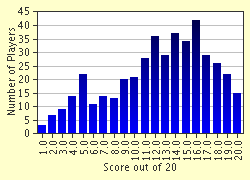
Bird Missing Letters Trivia Quiz
All the answers are the names of birds but unfortunately only four consecutive letters are given in the clue. Using additional letter(s) complete the words. You must look at the 'letter count' hint.
A multiple-choice quiz
by Inquizition.
Estimated time: 8 mins.
